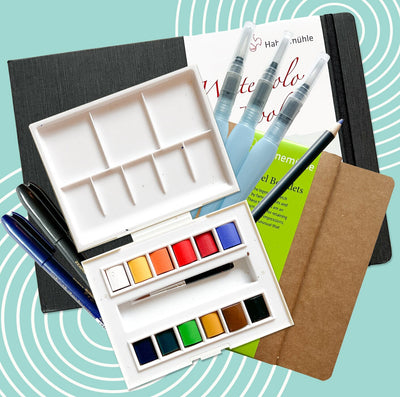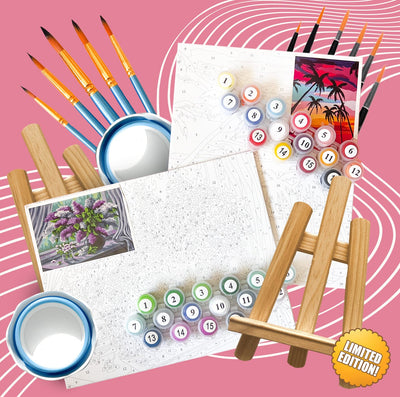Illuminated Manuscripts: Hand Lettering as Decoration
By Amy Hand
Hello Smart Art friends, and welcome to June’s blog!
We are so excited to be exploring hand lettering with you this month. From bullet journals to beautiful handwritten cards, some skilled hand lettering can really take writing and papercraft to the next level, and we want to help you do that. It may look intimidating, but if you follow our simple tips and tricks (and practice, of course), you’ll be executing the most stunning hand lettering in no time!
For us, the first thing that sprung to mind when thinking about hand lettering was an art form that began over 1000 years ago: illuminated manuscripts. Now you might be asking, what on earth is an illuminated manuscript? Don’t worry; we’ve got you!
Illuminated manuscripts are highly decorated handwritten books produced by skilled artisans as early as 1100 AD. They are said to have initially been created for Islamic texts, but the art spread liberally across Europe, and that is where we get most of the existing manuscripts left today.
When we talk about hand lettering taking things to the next level, there’s nothing that does it better than illuminated manuscripts, and we want to tell you all about them today.
So if you’re ready to dive into medieval times, let’s get into it!
The Birth of Illuminated Manuscripts
Illuminated manuscripts have been around for a VERY long time. When these stunning books came into existence in the Middle Ages, there were no printing presses, so all books were handwritten. Illiteracy was widespread, except for the upper classes and nobility, so demand for written books was low. The illustrations on these pages would serve as a depiction of what was happening in the text, so those who couldn’t read might be able to follow along.
Handwritten books may have been common, but it took a special kind of artist to handwrite and illustrate an illuminated manuscript, and these artists were often monks. Monasteries are the true birthplace of illuminated manuscripts and the incredibly skilled monks who created them.
As this may suggest, most illuminated manuscripts were religion-based and depicted scenes from the bible. These could take the form of large choir books that were often used for liturgical reasons within the church all the way down to tiny but exquisite hand-sized prayer books sported by the upper classes. However, their use also extended to some secular works like official laws, deeds, proclamations, and the like.
The name ‘illuminated’ came about as a reference to the decoration that often featured real gold and silver leaf that, quite literally, illuminated the page.
These manuscripts were often created as commissions for wealthy patrons. Their expense and stunning beauty made them a sign of status among the upper classes. Soon, they were clamoring outside the monastery to get their own illuminated manuscript or opulent prayer book to flash around at church.
An unexpected benefit of these books is that they were, essentially, pieces of art that were light and easily transportable. This made the spreading of ideas and artistic techniques far more accessible than the frescos and large-scale paintings that you would have to travel to view. In a society where communication could be long and laborious, these manuscripts became a novel way to spread religious messages and shed light on this grand art form.
Unfortunately, the call for these stunning creations decreased as mass printing became possible and the literacy of the general public became more prevalent. The demand for books grew, and the meticulous art slowly died out. They were still being produced by the early 16th century but almost exclusively for the church or the wealthy.
Many of these stunning manuscripts have been preserved and can be viewed in many European museums. They are now exclusively handled by gloved professionals and stored away from harsh light and fluctuating temperatures to protect the ink and prevent it from fading. The thousands of manuscripts left from the Middle Ages are some of the only evidence we have of art from specific periods, so their importance has only grown over time.
Hand Lettering As Decoration
Now let’s take a closer look at the materials and the actual layout of these pages.
The pages themselves were made from animal skin called vellum, which is why we have managed to salvage so many, as this will last longer than paper. Paper manuscripts were, however, used in the late Middle Ages. The lettering and paintings themselves were done using layers of ink and mineral-derived paints. This was then embellished with well-placed silver or gold leaf areas to truly illuminate the manuscript.
Each page would feature a section of text that uses a very similar hand-lettering technique to the one you’ll be learning in the box this month. It was so meticulously and delicately wrought that even the plain text on its own was a thing of beauty. The text would be strategically placed to fit around a beautifully rendered scene that depicted something from the text. The whole page would be finished with an intricate border of curlicues and floral patterns called marginalia.
Although the whole page is richly decorated, the most decorated part of the text itself is the first letter of every page. This was known as the illuminated initial. It would be enlarged to four or five times the size of the rest of the text to make room for some truly spectacular embellishment. The letter would be elaborately written and often gilded with a richly colored scene surrounding it. Some letters could even contain whole scenes featuring multiple people. This was a way of drawing the readers' attention, and I mean, wouldn’t it work on you too?
Some parts of the regular text might be emphasized using red to draw the reader's attention, known as rubrics. This might be used alongside a small section of floral patterns that was the same height as the text itself. There was really no area left unadorned.
After looking at the detail involved, it probably won’t surprise you to learn that one of these books could take up to 6 months to create. Each page was a piece of art on its own, let alone when combined with the rest of the book!
These books were often up to 400 pages and would be bound in leather to protect the art hidden inside.
See, we told you illuminated manuscripts were worth learning about! These books might be old, but their skill and beauty have stood the test of time and can still influence our own hand lettering to this day.
Although this style of hand lettering and decorating is painstaking and slow, we think it’s something that can easily translate to the journals and scrapbooks of contemporary artists just like you. You can even buy imitation gold and silver leaf in craft stores for relatively cheap to make your very own illuminated pages.
The next time you go to journal, why not consider jazzing up your page a little using the inspiration from this incredible ancient art? Not only will it look beautiful, but it will be enjoyable and rewarding too.
We hope this look into the magical art of illuminated manuscripts has inspired you to take your newfound hand lettering techniques and make something breathtaking! We can’t wait to see what you come up with!






